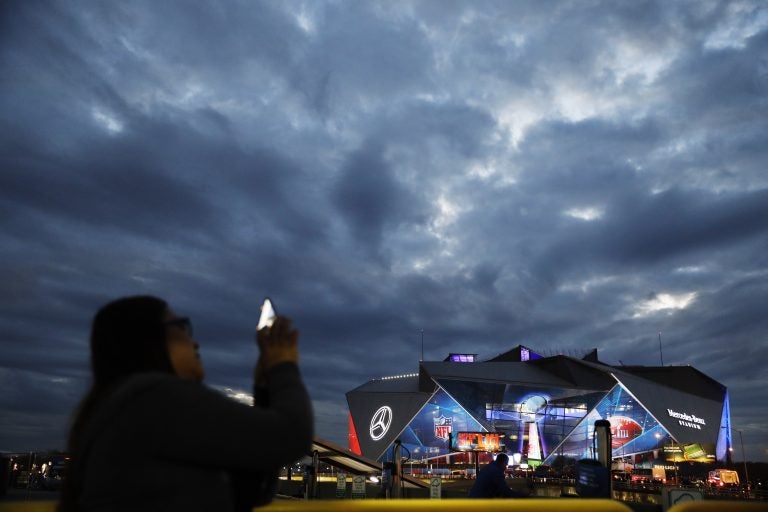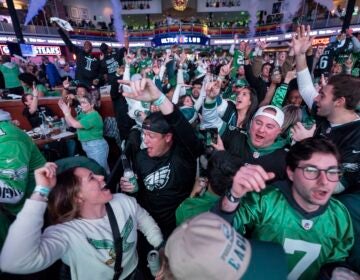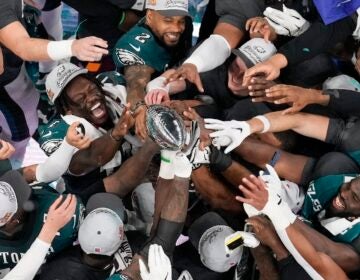Come together: Super Bowl Sunday, the last stand of live TV
Despite today's rapidly fragmenting modern-day viewing audience, most people want to watch their sports live. The Super Bowl is the biggest event of the year.

Mercedes-Benz Stadium is lit up ahead of Sunday's NFL Super Bowl 53 football game between the Los Angeles Rams and New England Patriots in Atlanta, Saturday, Feb. 2, 2019. (AP Photo/David Goldman)
Updated 3:56 p.m.
—
Oh sure, there’s plenty of evidence to support the soothsayers who are predicting the slow, inevitable death of live television.
And there’s plenty of proof to bolster theories about the NFL’s slipping popularity.
But when it comes to clicking away from Super Bowl Sunday — forget about it.
Whether streaming it digitally, firing up the cable box or heading to a friend’s house for chips, dip and commercials, it’s a good bet that cord cutters, antenna owners and everyone in between can be found right where they always are on this day — gathered in front of the TV set in massive numbers.
Exactly as they were 40 years ago.
Exactly as they were 20 years ago.
Almost certainly as they’ll be 10 years from now.
Fact is, despite today’s rapidly fragmenting modern-day viewing audience, most people want to watch their sports live. The Super Bowl is the biggest event of the year. As such, it is, by almost any measure, the last bastion of nationwide communal TV-watching we partake in anymore.
Of the 10 highest-rated television programs in U.S. history, nine were Super Bowls and one was the finale of “M.A.S.H.”
“It’s an outlier because, unlike pretty much everything else, it’s not an event we think of as being disrupted by streaming,” said Vince Gennaro, who studies America’s viewing habits as a dean at the NYU Preston Robert Tisch Institute for Global Sport.
Or disrupted by anything else.
And so, just as the increased choice brought about by cable couldn’t do anything to deter Super Bowl viewing, neither, it seems, will streaming, cord cutting or the Roku-ization of the American public — not even among the younger audience. A survey last week of 2,800 football fans by PCMag and Sports Illustrated found that 33 percent of respondents in the 18-to-24 age group said they would stream the Super Bowl this year. Most, however, planned to stream it straight to their television sets.
The survey found some concern among streamers who experience delays in their stream as compared to the live broadcast. But for the most part, their experience will be the same as watching it on cable — commercials and all.
That’s not to say the digitized nature of the 21st century won’t change some things.
“The idea of a Super Bowl party, with everyone sitting on their phone tweeting, is going to change the way we experience that Super Bowl party,” said Robert Thompson, the Syracuse pop-culture professor who will watch the game with pen and paper in hand, ready to take notes. “But it certainly doesn’t threaten it.”
What could threaten it?
Well, only two years ago, many Super Bowl stories (including this one by The Associated Press) warned of the potential beginning of the end of the NFL. The league was besieged by a concussion crisis, its own mishandling of domestic abuse cases, the still-fresh controversy over Colin Kaepernick’s kneeling during the national anthem, along with a steady stream of lackluster games that played as big a part as any in explaining the league’s diminishing ratings.
All the off-field issues still exist , with the added specter of a potential labor dispute two years down the road.
But the games were better this season, the ratings were up, and the season’s most high-profile mishap wasn’t related to player health or politics. Rather, it came on the field: the terrible no-call in the NFC title game .
Former CBS Sports president Neal Pilson was among the few who predicted ratings would rebound.
“The NFL had dramatically improved the schedule for Thursday and Monday nights,” Pilson said. “Plus, I thought the issues about the players were not going to be as big this year, and that turned out to be the case.”
Which is how we ended up with 18 of the top 30 most watched programs in 2018 as NFL games — much the same as the year before, and the year before that.
Maybe more telling: Last year’s Super Bowl between the Patriots and Eagles pulled in an average of more than 104 million viewers for a rating that was 250 percent higher than the No. 2 show on the list — the NFC title game from two weeks previous.
The Olympics bring people together, but they last more than two weeks and were held last year in a time zone half a world away. The opening ceremony was the 13th-most-watched program in 2018.
The Oscars used to command a massive audience, but last year, they tied for ninth and had their worst showing ever in the ratings.
“I’ve never received a call from someone wanting to talk to me about Oscar ads,” Thompson said.
The vast majority of Super Bowl ads don’t live up to the hype, even with a 30-second spot costing about $5.3 million.
Doesn’t seem to matter. Nor does it matter that one of the biggest drivers of the NFL’s popularity of late — fantasy football — is essentially a non-event this week with only two teams playing. Straight-up gambling — legal or no, the Super Bowl is the most heavily wagered-upon event in sports — will more than make up for that.
To sum it up, everything we thought about TV, viewing habits and even the NFL itself gets turned on its head for this one, magical day.
No matter who’s playing or what the score, the Super Bowl makes us all get together and party like it’s 1979.
“It’s hard to evaluate the Super Bowl as a football game on any level,” Gennaro said, “because it’s so much more than that.”
WHYY is your source for fact-based, in-depth journalism and information. As a nonprofit organization, we rely on financial support from readers like you. Please give today.




